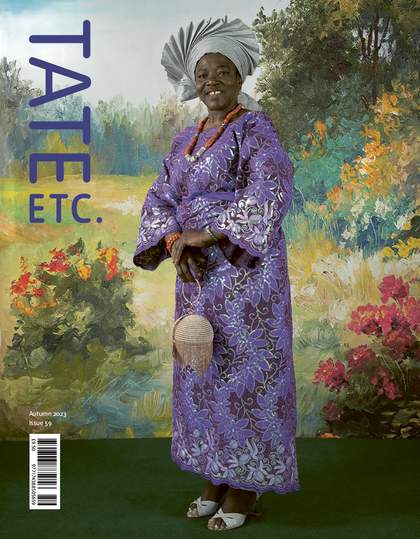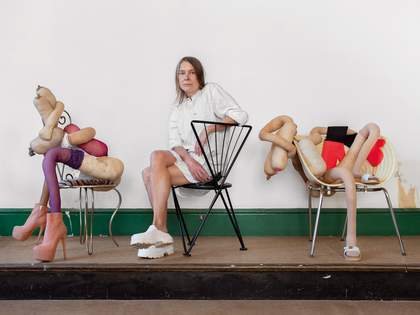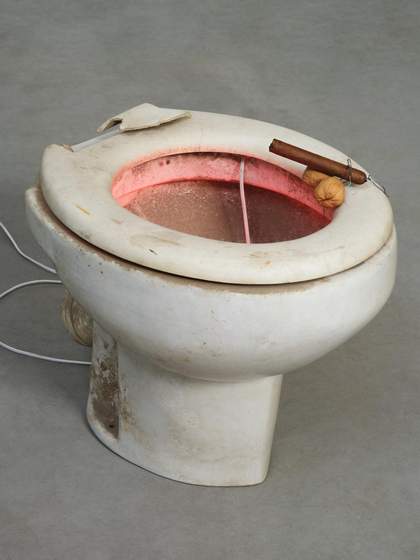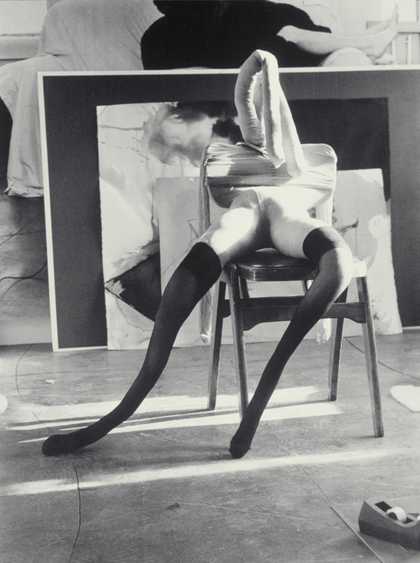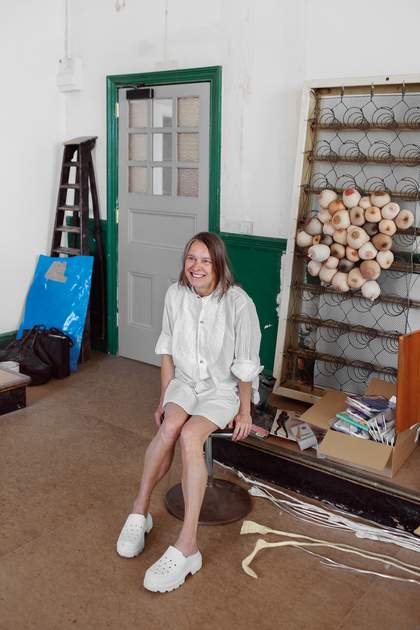
Sarah Lucas in her studio in Framlingham, Suffolk, photographed by Katie Morrison, June 2023
© Sarah Lucas. Courtesy Sadie Coles HQ, London. Photo: Katie Morrison
DOMINIQUE HEYSE-MOORE The title of your upcoming show, Happy Gas, describes the softest and lightest of states of being and matter. How do you want visitors to feel in the exhibition?
SARAH LUCAS Well, it’s a paradox that happiness reminds us of sadness, and that a sad story can be uplifting, or that something magical can come about through something mundane. I suppose that, when I’m making things, I’m looking for some kind of transcendence from everyday stuff into something more surprising.
There are two ideas at work in this exhibition. One is a story or picture, with each room depicting, loosely, a period of time – the things I made being a reaction, consciously or unconsciously, to those times and expressing how I felt, my point of view. The other is my decision to tell that story through the evolution of chairs in my work. When I first used chairs in The Old Couple, back in 1992, I didn’t know that I would continue to make use of them. As it turns out, they have been a consistent presence. In the earlier work, they are more passive and, as things have progressed, they’ve become a more active component.
I wouldn’t be at all surprised if a lot of people don’t even notice the chairs – as a main plank of the show, I mean. What I’m interested in is whether visitors have an emotional, gut reaction or a spontaneous humorous response. But I find I don’t like this question of how I want them to feel. It smacks a bit of the unrequited lover, scheming away to manipulate the beloved into loving. When I’m making things, I’m not thinking: ‘What are people going to feel about this?’ I’m reacting to the thing myself and having my own responses.
Having said that, I hope people will feel something, one way or another. I’d like them to engage with the show and for it to be an experience. Perhaps come out blinking into the sunlight. Naturally, I’d like to make a good show.
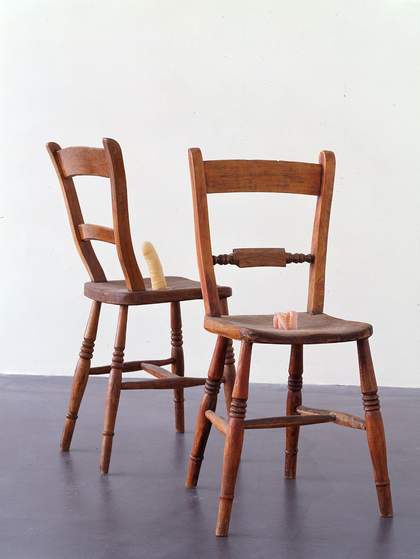
Sarah Lucas
The Old Couple, 1992
Wooden chairs, wax and flase teeth
© Sarah Lucas. Courtesy Sadie Coles HQ, London
DHM As you mentioned, this exhibition will include your earliest chair piece, The Old Couple 1992, through to your newest sculptures, like SEX BOMB 2022 and SLAG 2022, in which chairs are still used to support forms and figures. What fascination do chairs hold for you?
SL I’ve used them in all sorts of ways. The purpose of chairs is to accommodate the human body sitting. They can be turned to other purposes, though, generally as a support for an action or object: Changing light bulbs. Propping open a door. Posing. Sex.
My own (sculptural) purposes are no different. I use them as chairs for bodies, sometimes parts of bodies, and as stand-ins for bodies on occasion. Car seats, when glanced at through a windscreen – and particularly when they have headrests attached – can look like a couple of bodies, when seen from the corner of the eye while passing. Even empty chairs imply a body. It’s their meaning. Individual chairs have their own character too.
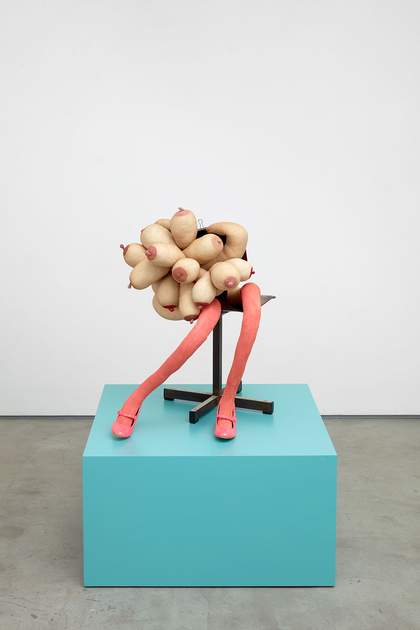
Sarah Lucas
SUGAR, 2020
Tights, wire, wool, bulldog clips, shoes, acrylic paint and metal chair
© Sarah Lucas. Courtesy Sadie Coles HQ, London. Photo: Robert Glowacki
DHM You challenge more than the nude in art history. What about the wide array of supports your sculpture sits on: toilets, breeze blocks, car seats, the floor, gigantic marrows, sandwiches?
SL As a younger artist I didn’t like plinths. A lot of my early work was very casually assembled, and I felt that putting it on plinths and pedestals would be too formal. Too grandiose. They seemed antithetical to the point I was trying to make, which was kind of no-frills. I thought they were overcompensating for some lack in the work itself – lending an authority that wasn’t otherwise there. I was looking for some kind of authority without the usual trappings and supports that we both take for granted and are convinced by – and are often manipulated by, like advertising tropes. I was looking for something unpretentious.
I once made a sort of plinth out of a bicycle that was turned upside down to rest on the floor standing on its handlebars. I stretched a plank of wood across the two wheels at the top and used it to display a set of cutouts of a bloke with fruit and veg on his genital area. These were cut from snapshots about five inches high and just showed his torso – no head or legs. That was some length to go to, really, to avoid having a plinth.
Using furniture happened at around the same time and for similar reasons. And I suppose my whole use of readymades stems from that too. Of course, readymades also come with their own meanings attached or implied, so that had to be taken on board and became another element in the mix.
Using breeze blocks is another matter. Although they do have meaning and implications, they’re relatively abstract. Whether they are concrete blocks or blocks of colour, I like them – as an abstract element, like colour or tone. They are an active part of the whole sculpture, rather than merely a presentation device. In fact, my early dislike of them has flipped over into excitement about what direction they might take in the future.
Breeze blocks have also proved very practical, as their arrangement can be adjusted at the drop of a hat. When artworks go from the studio to the exhibition, even if one has made a good plan – and I tend not to overplan anyway – it is still a surprise how things look in an unfamiliar space. The scale, for instance, will be different. So the adjustability of the blocks often becomes a key factor in getting the overall balance of the show – to do what I want it to do. I’ve been known to travel with a pallet of blocks.
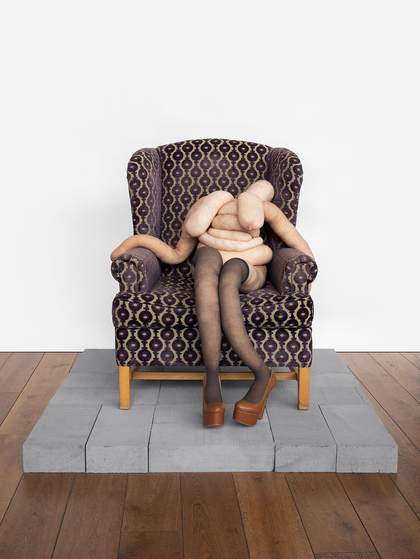
Sarah Lucas
FAT DORIS, 2023
Tights, wire, wool, shoes, armchair and breeze blocks
© Sarah Lucas. Courtesy Sadie Coles HQ, London. Photo: Katie Morrison
DHM The soft sculpture FAT DORIS 2023 and the cast work ANGEL 2022 sit into their bulging stomach folds, topped with slumping breasts and grounded with platformed stilettos. Older women’s bodies, experiences and sexuality are pointed at directly. You are famous for your use of humour – what role does this lightness have in your newest work?
SL I’ve been making what I call Bunnies for a long while now. The first one, from the mid-1990s, is in this show. I’m not constantly making them, but it’s something I’ve returned to from time to time and they’ve evolved over the years. It struck me, quite recently, that they’re mostly very thin. Or perhaps it would be more accurate to say, I had a sudden urge to make some fleshy ones. It must be a combination of the fleshiness and the saggy tits that make them appear old to you. The latter, probably. It turns out, surprisingly you may think, that a saggy tit is very expressive. I am also getting old myself, of course. I’ve got my bus pass, there’s no denying that.
DHM You are asked a lot about penises, because you often make them – and they are well represented in the exhibition. But vulvas and other openings have also had as long a presence in your practice – mouths, gutted meat, the gussets and seams of tights, shoes, the holes for placing cigarettes in the orifices of your plaster-cast muses (Sadie, Pauline, Michele 2015) – and still have the power to shock and amuse. Why vulvas, and what responses to your explicit use of them do you notice?
SL Well, partly because, as you say, I’ve made a lot of penises, and partly because I have one. A vagina, that is – not an absence of penis. Funnily enough, the vaginas seem to shock people more than the penises. Especially the plaster casts of real ones. I’ve seen people approach some of the muses and, when they’re close enough to get the vagina into focus, about-turn and walk away. This feels like an experience on a par with, or maybe opposite to, finding out the meaning of the word ‘cunt’. I remember, as a child, being quite baffled by this word, which I’d heard bandied about a lot and definitely understood enough to know it was out of the question to ever use it in front of adults. It was, seemingly, the harshest and worst term of abuse available in four letters. And I had one myself. Shocking.
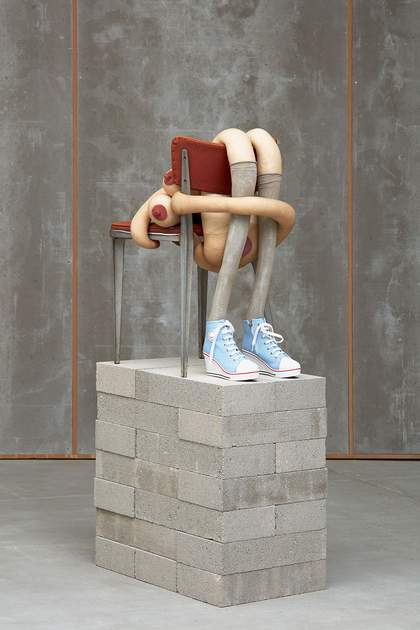
Sarah Lucas
PEEPING THOMASINA, 2020
Tights, wire, wool, shoes, acrylic paint, vinyl and metal chair
© Sarah Lucas. Courtesy Sadie Coles HQ, London. Photo: Robert Glowacki
DHM You have always moved between soft and hard materials, often placing them in direct tension, and your work also takes us through soft and hard states of emotion – arousal, depression, jubilance, rage, vulnerability and tenderness all find form. How do you settle on the right materials to express all this?
SL What I look for in materials is readiness. Something I can get on with in a spontaneous way and just do myself. It might well be that I’m doing this at home at some odd hour of the day. Often the things that are there aren’t generally credited with being an art material – like tights, or cigarettes, or an onion. The important thing for me is to be able to act on it there and then.
The states you refer to are the usual gamut of emotions we might find ourselves subject to. The stuff of tragedy and comedy. Of daily grind and boredom. Of living. And I find myself subject to these things like everybody else. Often I feel a tremendous urge to do something with that feeling right away, with whatever there is about, even if at first glance it looks like there’s nothing very promising available. And that’s gratifying and often amusing – to express the anxiety or the anger or the joy with an onion or a chair. There is always something.
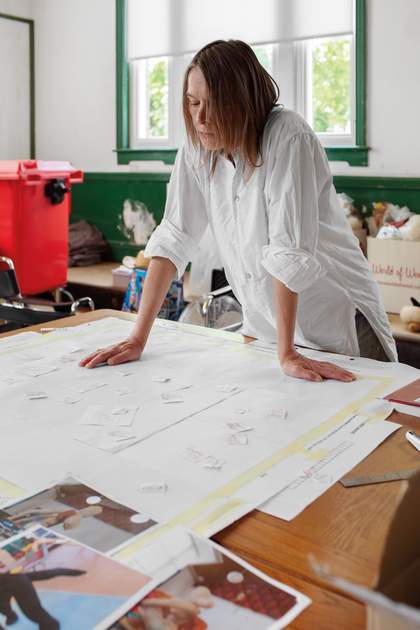
Sarah Lucas with the plans for her Tate Britain exhibition in her studio, June 2023
© Sarah Lucas. Courtesy Sadie Coles HQ, London. Photo: Katie Morrison
Sarah Lucas is an artist who lives and works in Suffolk and London.
Dominique Heyse-Moore is Senior Curator, Contemporary British Art, Tate Britain.

